During World War II, a massive recruitment effort targeted students from the top art schools across the country. These young designers, artists, and makers were being asked to help execute a wild idea that came out of one of the nation’s most conservative organizations: the United States Army.
The crazy idea was this: The United States Army would design a “deception unit”: a unit that would appear to the enemy as a large armored division with tanks, trucks, artillery, and thousands of soldiers. But this unit would actually be equipped only with fake tanks, fake trucks, fake artillery and manned by just a handful of soldiers.
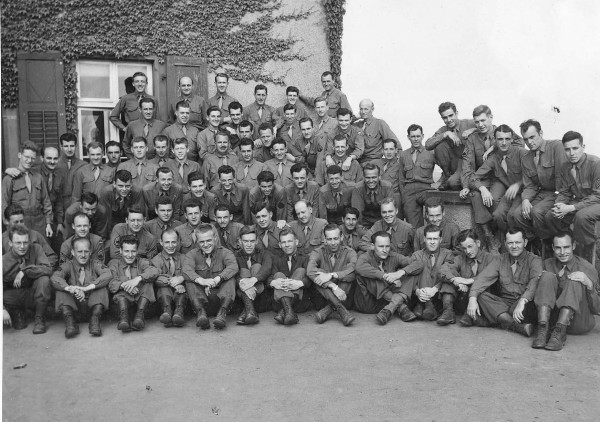
June 6, 1944, marked the start of the most critical period of World War II. The Allies landed on the beaches of Normandy and began to liberate France from Germany, who had occupied it for four years. The success of D-day was due, in part, to deception. Using a variety of techniques, the allies were able to trick the Germans into thinking the invasion would happen at a different time and place.
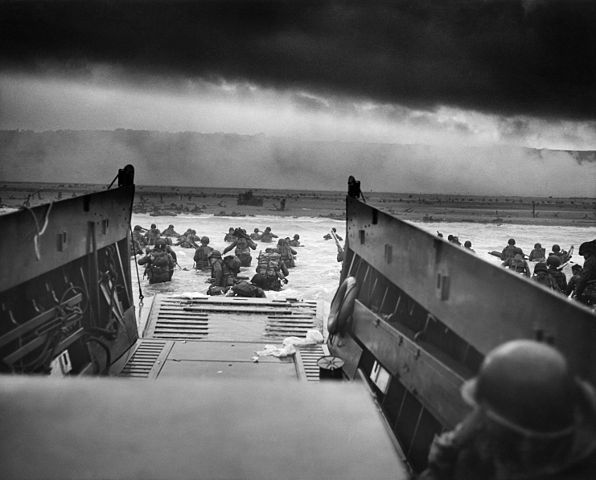
Then, a couple of U.S. Army men stepped in with an idea. Ralph Ingersoll and Billy Harris, who had learned some deception techniques from the British, wanted to take deception to a whole new level. They wanted to create a mobile deception unit.
The army created a top-secret unit officially called, “The 23rd Headquarters Special Troops.” After the war, it was nicknamed “the Ghost Army.”
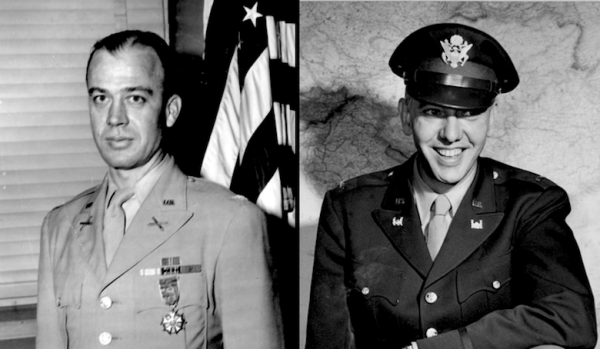
The so-called Ghost Army would impersonate a specific larger division, such as the 6th Armored Division, which had fifteen to twenty thousand soldiers. Only about a thousand soldiers comprised the Ghost Army.
To pull off this deception, the Ghost Army used tanks, jeeps, and artillery all made from inflatable rubber.
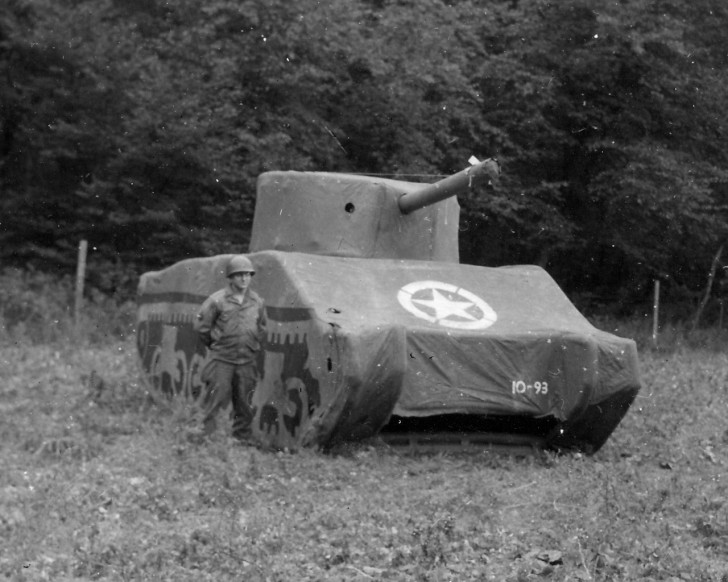
For the charade to be believable, soldiers in the Ghost Army had to pay extreme attention to detail. An inflatable tank might look real enough on the ground from a distance, but aerial reconnaissance could reveal a conspicuous lack of tank tracks. So the Ghost Army would use a bulldozer to make fake tracks around the fake tanks.
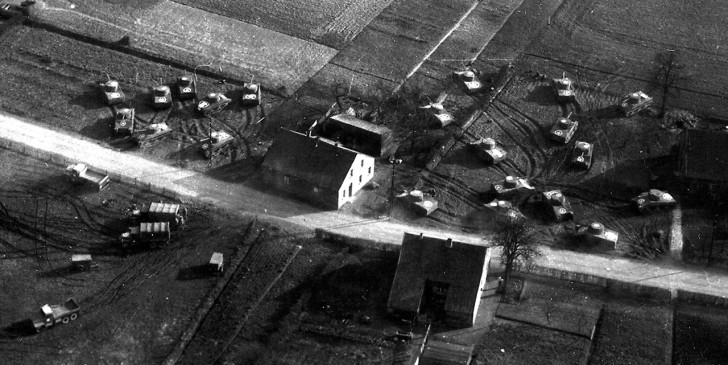
There was one cardinal rule about working with inflatables: never carry one across a road, or in any other place where you could be seen. Obviously, two men carrying a 40-ton tank would be a dead giveaway.
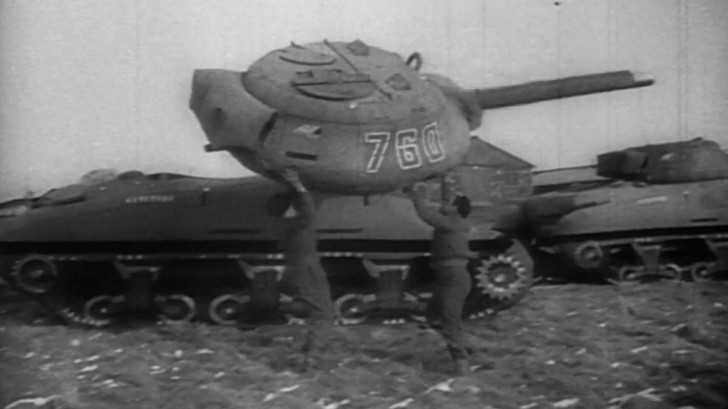
When they weren’t busy with their dummy tanks, the artists in the Ghost Army spent their time sketching each other as well as local people and architecture.
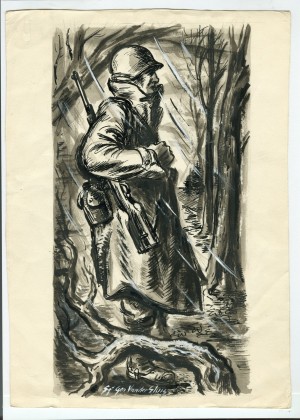
Some of the artists in the Ghost Army went on to be quite successful: Ellsworth Kelly, minimalist sculptor and painter; Bill Blass, the fashion designer; and Jack Masey, a designer who has worked on numerous world expositions and museums.
During their travels through Europe, when they weren’t sketching, the Ghost Army was often acting—literally impersonating whichever unit they imitating at the time. They made fake patches to put on their sleeves and stenciled fake unit numbers on their trucks.
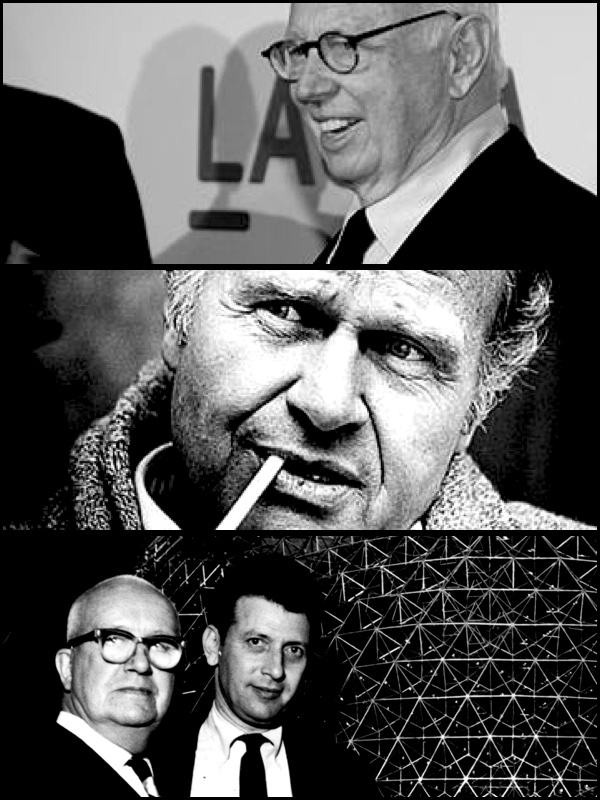
While passing through local towns the ghost army would put on a show for any German spies that might still be lingering in French cafés or bars.
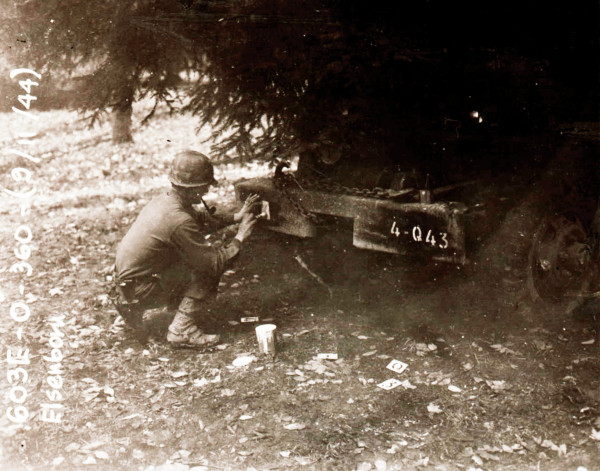
On the battlefield, the Ghost Army also did “sonic deception.” The sonic deception unit would record the sounds of troops amassing in tanks and trucks and then be able to play those sounds back over loudspeakers.
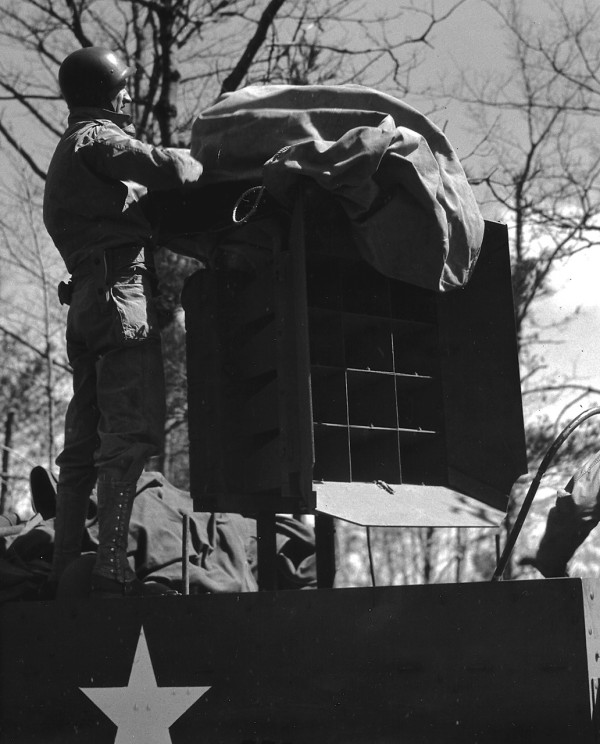
The Ghost Army had a library of recordings of different engines moving over different terrain. Sonic Deception was so new to the Army that they made a top-secret film (screened for a chosen few) to explain how it worked.
The third component of the Ghost Army was the radio operators. It was well known that the Germans listened in on radio communications of allied troops, so if the Ghost Army was trying to impersonate a real armored division, they’d have send the right kinds of transmissions.
The radio operators had to be perfect mimics. They had to learn the exact keystrokes of an individual Morse Code operator in the unit they were impersonating.
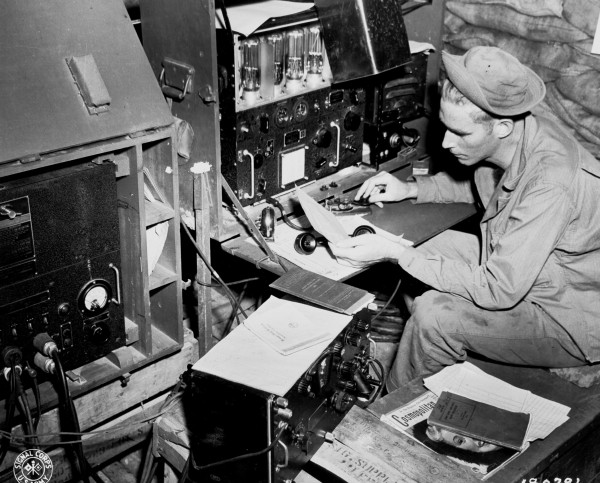
The three different units in the Ghost Army—visual, sonic, and radio—were operating separately but were organized by the same people and were working on different components of the same plan.
The Ghost Army carried out twenty-one deception missions between June 1944 and March 1945—nearly the entire time the U.S. Army was operating in Europe. One of these was Operation Bettembourg, in which the Ghost Army filled a 75-mile gap in the American line of troops for 7 days until an actual armored division could come in and take their place.
Over the course of the war, the Ghost Army lost three soldiers and had several dozen wounded, but overall it was one of the safer assignments of WWII. And in the end, the crazy idea of a “mobile deception unit” worked. They fooled the Axis powers, they held the line, and they saved lives.
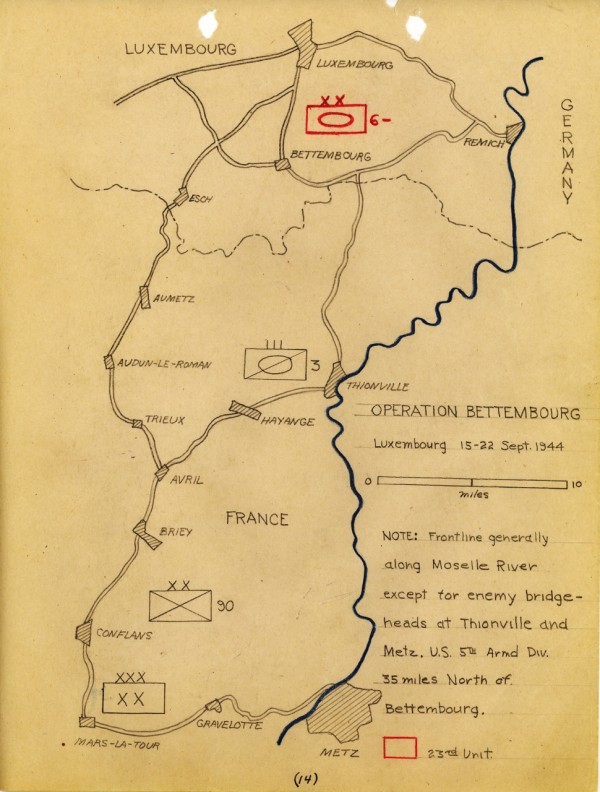



Comments (18)
Share
A great episode. The “German tank problem” (http://en.wikipedia.org/wiki/German_tank_problem#Historical_problem) makes for a nice addendum if you want to know why even serial number design can be important when planning deceptions. In short: Allied forces could nearly perfectly predict the number of German tanks produced during WW2, as the Germans were using consecutive serial numbers. :-)
^^ that is super cool, thanks for sharing.
Woooow! Rubber tanks! :D
I live in Minnesota and on our PBS television station tonight is a program about the Ghost Army! 99pi this morning and PBS in the evening — on the same topic!
Great story, well presented! Only one nit… When you add Morse Code sounds to the Podcast audio backdrop, you might want to use something other than one Ham radio operator calling another. War is deadly serious, but I burst out laughing when I heard “CQ” (Dah-di-dah-dit Dah-dah-di-dah), obviously not the original event, in the segment on the radio operators.
To add a little to your story, experienced Morse Code operators have long been able to recognize each other by listening to how their code is sent, called their “fist”. It’s like listening to someone’s voice accent, and to be totally effective, I would expect the Ghost operators would have had to mimic different fists during their work, in order to not be recognized. Do you know if they did this?
Keep up the good work!
This was a great episode! I had heard about this before, but never in such detail. I’ll definitely be checking that book out!
I work at a visual arts residency based out of Maine. It was founded in 1946 by several WWII artists, though I’m not sure any of them worked in this deception unit. However, Ellsworth Kelly, and a lot of other artists who were, were among the first participants. There’s definitely an interesting line of inquiry to be drawn between the founders of Skowhegan (where I work), who were mainly used for realistic battle documentation and continued to make mostly figurative art, and those artists who were in the deception unit, who I think largely went on to make more avant-garde works post-war.
Wow! I had heard of the ghost army before, I but never knew the role of inflatables in its success. That gives a whole new dimension to Michael Sailstorfer’s “T 72”. It was on view in 2010 at ARTER, a gallery in the Beyoğlu district of Istanbul, near Taksim square:
https://youtu.be/q0xrTCY18ts
Does anyone know if the audio archives still exist? The sound effects used for the sonic deception is what I’m looking for. I would love to use them for some upcoming music I’m writing…
I was surprised that for your Classical analogy you went with the Trojan Horse and not the Biblical story of Gideon, which is exactly using audio and visual trickery in a show of force.
This was such a cool episode! The Ghost Army if fictionalised in Kurt Vonnegut’s ‘Bluebeard’ – the hero Rabo Karabekian was a member of the army of artists and maintained a troubled relationship with representational versus abstract art for the rest of his life.
Thanks for mentioning this, I was hoping someone would! A great Vonnegut book, especially if you like breakfast of Champions where Rabo Karabekian reappears.
I VISITED THE ARMY ENGINEER PROVING GROUNDS AT FORT BELVOIR IN THE EARLY 1960s . BY THEN, 18 YEARS AFTER THE WAR, THE ARMY’S EFFORT HAD SHRUNK FROM 1000 OR MORE TO JUST FOUR PEOPLE . THEY WERE STILL ENGAGED IN DECEPTION R&D . THEY WERE VERY PROUD OF THEIR PROOF-OF-CONCEPT FIBERGLASS JEEP, WHICH FOUR SOLDIERS COULD PICK UP AND MOVE WITH EASE . IT WAS INDICATIVE OF THE STATE OF THE EFFORT THAT THE JEEP WAS ONE OF A KIND AND THE ARMY HAD ALREADY BEGUN PROCURING A DIFFERENT-LOOKING OPERATIONAL JEEP. ALSO THERE AT BELVOIR ( AND THEY MAY STILL BE THERE ) WERE BUNKERS CONTAINING DEVICES USED TO GOOD EFFECT DURING WW-II . EXAMPLES WERE THE TINY PARATROOPERS DROPPED AT NORMANDY AND THE “CRICKETS” ISSUED TO IDENTIFY FRIENDS TO FRIENDS . THE RUBBER TANKS HAD ALL BECOME PILES OF ROTTING RUBBER . I DID NOT SEE THESE THINGS BUT WAS TOLD ABOUT THEM DURING MY VISITS . I DID SEE THE JEEP. – – TOM LOGAN – – BTW THE PRINCIPAL BEHIND THE TROJAN HORSE IS JUST AS VALID TODAY AS IT WAS IN BIBLICAL TIMES . SO ARE SOME OF THE GADGETS IN THE BELVOIR BUNKERS
I’m wholly mesmerized, captured and held prisoner by this fascinating story. A wonderful effort!
This Ghost Army work was a core plot element in Ken Follett’s fictional spy novel “Eye of the Needle.” A Nazi spy in England uncovers the pre-D-Day deception and is trying desperately to get word back.
I’m a former Army psyop specialist and thought this episode was great! I once pretended to be a tank column using tank recordings broadcast over a jeep-mounted loudspeaker system. No mention was made of the Ghost Army in our training. Not sure why.
check out the story of “Tzvika Force”: https://en.wikipedia.org/wiki/Zvika_Greengold
So the first time I heard about the ghost army I was reading up about one guy who worked in intelligence and was also important to deception operations in his own way. I originally found his crazy story in a book but here is his wikipedia article: https://en.wikipedia.org/wiki/Juan_Pujol_García
I served aboard a cruiser in the early 1980s and while on a Mediterranean cruise, we moved into the Gulf of Sidra, to perform “freedom of Navigation” exercise under the cover of darkness. We were equipped with a special unit that could play different audios on known frequencies that made us appear as the USS Nimitz, an aircraft carrier and home to the squadron of F14 fighters which had shot down two of the LAF planes in a recent skirmish.
Our hope was that the Lybian Air Force would come out and attack us. Nothing ever happened but it was interesting to know that we were deployed as bait specifically as a ruse to see what we could stir up.